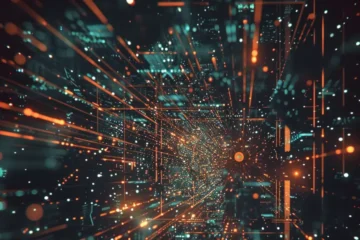The energy sector is at a fascinating crossroads. On the one hand, we’re witnessing the rapid acceleration of renewable energy adoption and sustainability initiatives. On the other, there’s a rising tide of market volatility, regulatory complexity, and technological innovation.
As someone deeply involved in developing technology solutions for complex industries, I find Energy Trading and Risk Management (ETRM) systems to be one of the most exciting and critical areas of software evolution. Let’s explore how this domain is transforming, not just with facts and figures but with real-world stories and ideas for what lies ahead.
Market Forces Shaping the Future of ETRM
A few years ago, I was consulting for a large utility company struggling to manage the growing complexity of its trading operations. They had recently expanded into renewables and were grappling with entirely new challenges—unpredictable weather patterns, fluctuating energy prices, and an avalanche of regulatory requirements. Their legacy ETRM system was stretched to its limits, and they could not keep up with the rapid changes in the energy landscape.
This is a story I see repeated across the industry. The energy transition is driving a paradigm shift. Companies are adding solar, wind, and battery storage to their portfolios, and traditional trading systems—built for fossil fuels—aren’t equipped to handle the variability of renewables.
At the same time, market volatility is becoming the norm. Energy prices can swing dramatically in response to geopolitical events, supply chain disruptions, or even a tweet from a major policy influencer. The old ways of managing risk are no longer sufficient. Modern Energy Trading and Risk Management must be agile and intelligent, capable of responding to these changes in real time.
Trend #1: Cloud-Native ETRM Platforms
Cloud technology is no longer optional—it’s essential. I remember a conversation with a C-level executive at an oil and gas company who admitted that their on-premises ETRM system was becoming a bottleneck. Every time they needed to scale up during peak trading periods, it took weeks to provision new servers and deploy updates. By the time their system caught up, the opportunity was often lost.
Enter cloud-native ETRM platforms. With the cloud, scalability is no longer an issue—it’s a given. Companies can increase capacity on demand, collaborate across global teams, and access real-time data from anywhere. According to an Accenture report, cloud adoption in the energy sector has become a $37 billion annual investment, with companies achieving greater agility and cost efficiency.
What to ask for in your ETRM requirements:
- Ensure the platform can scale dynamically to match market conditions.
- Insist on robust security measures, as cloud environments can be a target for cyberattacks.
- Look for real-time data synchronization across all devices and locations.
Trend #2: AI and Machine Learning for Smarter Risk Management
The first time I saw an AI-powered trading system in action, it was like watching a skilled chess player anticipate moves ten steps ahead. AI-powered predictive analytics can identify market trends and risks long before they become apparent to human analysts.
Based on the market data, typical energy companies using machine learning can improve their demand forecasting by at least 15%. This may sound modest, but in a market where margins are razor-thin, that improvement translated to millions in annual savings. AI also helped them spot anomalies in their trading data—early warnings of potential fraud or operational inefficiencies.
Key features to include in your Energy Trading and Risk Management:
- Advanced AI models for risk assessment and demand forecasting.
- Real-time anomaly detection to flag unusual trading patterns.
- AI-driven optimization for portfolio management.
Trend #3: Blockchain for Transparency
Blockchain isn’t just for cryptocurrency anymore. In energy trading, it’s becoming a cornerstone for transparency and trust. I recently met with a consortium of energy companies experimenting with blockchain to streamline their settlement processes. Using smart contracts in Energy Trading and Risk Management, they reduced transaction times by 40% and eliminated disputes over trade details.
For energy companies dealing with carbon credits or renewable energy certificates, blockchain offers a secure way to track and verify transactions. This not only simplifies compliance but also builds credibility with investors and regulators.
How to integrate blockchain into your ETRM system:
- Specify the need for secure transaction recording using a blockchain ledger.
- Incorporate smart contracts to automate trade settlements.
- Ensure the system supports audit trails for regulatory compliance.
Trend #4: Advanced Visualization and Decision-Making Tools
At one point, I worked with a trading desk that still relied on old-school spreadsheets for decision-making. Let me tell you, it was like watching someone try to solve a jigsaw puzzle without knowing what the final picture looked like. Traders would spend ages digging through endless rows of numbers, trying to make sense of it all before making their moves. It was painfully slow, full of potential for errors, and the stress was palpable.
Today’s ETRM software is a far cry from those days. Not all, but most contemporary platforms provide streamlined dashboards with real-time data visualization, scenario modeling, and predictive insights. One client I collaborated with was able to cut their decision-making time by 25% just by implementing an interactive dashboard.
What to look for in visualization tools:
- Customizable dashboards that cater to different user roles, from traders to executives.
- Scenario simulation features to test “what-if” scenarios before making a trade.
- Real-time alerts and insights to stay ahead of market shifts.
Trend #5: IoT and Big Data Integration
The Internet of Things (IoT) is generating vast amounts of data across energy grids, pipelines, and trading floors. The challenge isn’t collecting this data—it’s making sense of it. Big data analytics can process terabytes of information to uncover patterns and opportunities that would otherwise go unnoticed.
For example, a utility company I know used IoT sensors to monitor its grid and combined this data with weather forecasts to predict power demand. The result? A 20% improvement in grid efficiency and fewer costly blackouts.
What to include in your requirements:
- Integration with IoT devices for real-time data collection.
- Advanced analytics to process and interpret large datasets.
- Predictive maintenance capabilities to reduce downtime.
Trend #6: Cybersecurity as a Priority
The more connected we become, the more vulnerable we are to cyber threats. A recent Deloitte study found that 47% of energy companies experienced a cybersecurity breach in the last year. The risks are especially high for trading platforms, where a single breach could result in millions of dollars in losses—or worse, a loss of trust.
How to protect your Energy Trading and Risk Management Software:
- Implement end-to-end encryption for all data.
- Use multi-factor authentication to secure user access.
- Invest in continuous monitoring and threat detection.
The Human Element in Energy Trading and Risk Management Development
It’s easy to get caught up in the technology, but let’s not forget the people who use these systems. When specifying requirements for an ETRM platform, involve stakeholders from across your organization—traders, analysts, IT teams, and executives. Their insights will ensure the system meets real-world needs and drives adoption.
Final Thoughts
The energy sector is constantly changing, and our systems must evolve to keep up. Whether adopting AI, embracing the cloud, or integrating blockchain, the key is to stay flexible and forward-thinking.
If you’re navigating these challenges and looking for guidance, reach out. At Artelogic, we specialize in building ETRM solutions that empower companies to thrive in a volatile, fast-changing world.

New Trends in Energy Trading and Risk Management Software

7 Common Mistakes in Software Requirements Specifications










